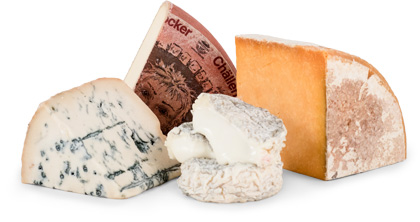Stilton, first made in the Midlands of England, takes its name from the village of Stilton. Ironically, Stilton has never been made there. The blue cheese was actually made in a nearby town, Melton Mowbray, but sold in the shops of Stilton. Stilton is approximately 80 miles north of London, along what was called the Great North Road. Coaches traveling between London and Scotland and other cities to the north of London made Stilton their first stop (usually overnight) on the trek north—a place to freshen their horses and themselves. The village was a center marketplace for cheeses of the region. Travelers of the day were so smitten with the blue cheese found there that word of its remarkable flavor spread far and wide. So it was that Melton Mowbray's famed blue cheese acquired the name "Stilton."
Today Stilton is made much the same way as it was in the 1700's. So esteemed is Stilton's unique flavor and texture, it is the only British cheese graced with its own certification trademark. In 1936, The Stilton Cheese Makers Association was formed to maintain the quality standards and protect the trademark of Stilton. Long considered "The King of Cheeses" by many connoisseurs, blue Stilton is one of a handful of British cheeses granted the status of a "protected designation origin" (PDO) by the European Commission. This means only authorized creameries can make true Stilton. They operate in just three counties of England: Leicestershire, Nottinghamshire, and Derbyshire.
Each morning fresh pasteurized milk is fed into an open vat to which acid-forming bacteria (starter cultures), a milk clotting agent (such as rennet) and "penicillium roqueforti" (blue mold spores) are added. Once the curds have formed, the liquid whey remaining is removed and the curds are allowed to drain overnight. The following morning, the curds are then combined into blocks to allow further drainage before being milled and salted. Each cheese requires about twenty-four pounds of salted curd, which is fed into cylindrical molds. The molds are then placed on boards and turned daily to allow natural drainage for five or six days. This ensures an even distribution of moisture throughout the cheese so that it creates the flaky, open texture required for the important bluing stage. The cheese is then transferred to the storeroom, where temperature and humidity are carefully controlled. Each cheese is turned regularly during this ripening period.
So how does this cheese get blue? As described, the basic recipe for blue cheese starts like any other cheese. The difference is the addition of the blue mold spores to the milk. Since mold needs air to grow, the cheeses are pierced with stainless steel needles when they are about six weeks old and have formed the traditional Stilton crust. The piercing allows air to enter the body of the cheese, permitting the growth of its famed blue veins. At about nine weeks of age—at which time each cheese weighs about seventeen pounds—the cheese is ready to be sold. Before being sold, though, every cheese must be graded. This is done via a cheese iron, an instrument that bores into the cheese and extracts a plug of it. By visually inspecting and smelling the plug, an experienced cheese grader can determine whether the cheese meets the standards required to allow it to be sold as Stilton. Cheese that doesn't meet the Stilton criteria will be labeled and sold simply as "blue cheese."
Milder than Roquefort or Gorgonzola, Stilton has a rich and mellow flavor with a pungent aftertaste. The finest Stilton is creamy with a subtle, yeasty sweetness and a salty, nutty finish. In fact, the way to judge the quality of your Stilton is by how creamy it is, not by how blue it is. Stilton is excellent for crumbling over salads or as a dessert cheese, served with a Port Wine. Be sure to let your Stilton come to room temperature before enjoying!

Experience International Variety
You might receive a Gaperon, originating in France during the 14th Century, an
authentic Lancashire by Ruth Kirkham, and an Italian Taleggio matured in the
caves of Valsassina…all in one shipment!

